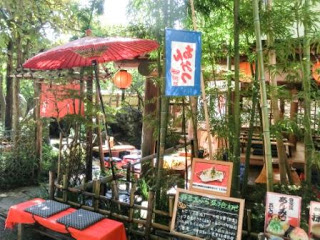The Best Japanese Soba Noodles in Tokyo! – Restaurants for New Year’s Eve
Tokyo Direct Guide is for everyone interested in traveling in Tokyo & Japan – From beginners to adventurers. I’d like to end this year with a story of a maniac place in Tokyo and a Japanese custom.
Do you remember A Trip to Jindaiji? It is a country place inside Tokyo with interesting culture.
Today’s topic is the food. Jindaiji is famous for Japanese noodles (soba in Japanese. Made from buckwheat) cooked by pure spring water there.
I, who can tell good or bad about soba as I’m telling you in the following, promise you that Jindaiji Soba is excellent.
I entered Shimadaya, which was established in Mid-19th century and the manager is the 5th generation now.
 |
| Shimadaya, one of Jindaiji Soba Restaurants |
I ordered Soba & Wild Grass Tempura Set.
 |
| Soba & Wild Grass Tempura Set at Shimadaya |
The recipe of soba is very simple. The noodles are made from buckwheat, flour and water kneaded together, and when you buy them in a supermarket, they have been sliced. So what you need to is just boil them like spaghetti, and soak them into the ready-made soup when you bring them into your mouth.
What is different here is that the noodles are cooked from the dough by the restaurant, not by a wholesaler. Can you see the width of each noodle? The differences are the proof to be handmade.
 |
| It’s Handmade! |
The soy-source-based soup and some wasabi (if you like) are prepared in the restaurant, too.
I can’t forget the moment I had the first nibble… The soup was moderately strong, and the noodles tasted clear. Generally, buckwheat is an ingredient that tends to be heavy on your stomach, but it didn’t happen to me at all here!
 |
| I really LOVED this – So delicious!! |
There was dengaku (= konjak with miso) as a side dish. Amazingly it caught my heart, too!
 |
| Dengaku (The maple leaf is a decoration. Don’t eat!) |
The restaurant is located just beside a pure pond next to Jindaiji Temple, which shows us unique and beautiful views.
 |
| A small shrine of the restaurant and the pond surrounding it |
Even carp is living inside the restaurant!
 |
| Welcoming CARP at the restaurant |
I saw how important the spring water is in Jindaiji. And the soba set made my trip fantastic beyond expectations.
Actually, I had NOT expected much to Jindaiji soba until I visit there because of my bitter memory. When I was young, I traveled in a city that is famous for soba in Japan. I was excited when I entered a great restaurant on my guidebook, but… Nothing was good there. Slow service, high prices, and disappointing tastes. The restaurant was very disappointing to the point that I haven’t forgiven them! Since then, I hadn’t trusted any “soba-dokoro (= districts that are famous for soba.)”
So I don’t think all the soba-dokoros are good, but I really feel that Jindaiji Soba is genuinely excellent to the point that I want to try all the restaurants!
There are more than 20 soba restaurants around Jindaiji Temple, and each is particular about their proud tastes.
 |
| Yaoki – With bamboos and spring water inside the restaurant |
 |
| Tamaya – Surrounded by tall trees |
 |
| Suzuya – Restaurant-like looks and lanterns |
Each of them features different looks as well as tastes, so just enter the one which attracts your attention!
(Most restaurants open around 10 or 11. Please note that Jindaiji is a district around a temple like Nakamise Street in Asakusa, so some of them close around 16:00, and all are close at night normally.)
In Japan, there is a custom to eat soba with hearing Watch-Night-Bells tolled 108 times to brow away bad desires in temples at 0:00. (It is an official story. Many people have soba in daytime. That’s OK!) It is called toshi-koshi-soba, which means the noodles on New Year’s Eve. That’s why I chose this topic for the last post of this year.
Are you ready for the New Year?
If you are having a great holiday in Japan in this season, I definitely suggest you to have toshi-koshi-soba to experience Japan more.
And everyone, let’s fulfill your mind with Mt. Fuji so that it appears in your first dream, which is considered to be very lucky in Japan.
Have a Wonderful New Year & see you again on Tokyo Direct Guide/Diary in 2016!
Helpful Links
Visitor Information of Jindaiji
Open this. I wrote about things to do and see in Jindaiji with photos. How to get to Jindaiji from Tokyo City, which I believe is the simplest explanation on the web, is at the bottom.
http://tokyo-direct-guide.com/ All-In-One, The Quickest Travel Guide Site of Tokyo





